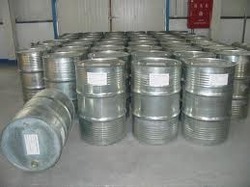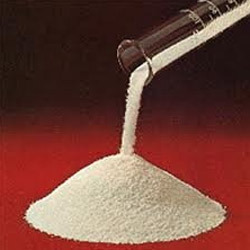Epichlorohydrin Chemical
Epichlorohydrin Chemical Specification
- Purity
- 99%
- Boiling point
- 116 C
- Smell
- Chloroform-like, pungent odor
- Shape
- Liquid
- Melting Point
- -25 C
- Form
- Clear colorless liquid
- Other Names
- 1-Chloro-2,3-epoxypropane; 2,3-Epoxy-1-chloropropane
- Storage
- Store in cool, dry, well-ventilated area away from heat and sources of ignition
- Density
- 1.181 Gram per cubic centimeter(g/cm3)
- Poisonous
- Yes
- Molecular Formula
- C3H5ClO
- Molecular Weight
- 92.52 g/mol
- Structural Formula
- ClCH2-CHOCH2
- Refractive Rate
- n20/D 1.439
- Ph Level
- Not applicable / Not determined
- HS Code
- 29103000
- Taste
- Not applicable / Not determined
- Solubility
- Slightly soluble in water, miscible with most organic solvents
- Classification
- Organochloride / Epoxide
- Chemical Name
- Epichlorohydrin
- CAS No
- 106-89-8
- EINECS No
- 203-439-8
- Grade
- Industrial Grade
- Standard
- Complies with industrial chemical standards
- Type
- Synthetic Organic Compound
- Usage
- Industrial, Manufacturing, Chemical Synthesis
- Main Material
- Epichlorohydrin (ECH)
- Application
- Used in production of epoxy resins, surfactants, elastomers, water treatment chemicals, synthetic glycerin, and as a solvent
Epichlorohydrin Chemical Trade Information
- Minimum Order Quantity
- 1 ,
- Payment Terms
- Paypal, Letter of Credit (L/C), Western Union, Cash in Advance (CID), Cash Advance (CA)
- Supply Ability
- 50 Per Week
- Delivery Time
- 7 Days
- Sample Available
- Yes
- Sample Policy
- Sample costs shipping and taxes has to be paid by the buyer
- Main Export Market(s)
- Western Europe, North America, Eastern Europe, Central America, Middle East, South America, Asia, Australia, Africa
- Main Domestic Market
- All India
About Epichlorohydrin Chemical
Epichlorohydrin (abbreviated ECH) is an organochlorine compound and an epoxide. Despite its name, it is not a chlorohydrin. It is a colorless liquid with a pungent, garlic-like odor, moderately soluble in water, but miscible with most polar organic solvents. It is a chiral molecule generally existing as a racemic mixture of right-handed and left-handed enantiomers. Epichlorohydrin is a highly reactive compound and is used in the production of glycerol, plastics, epoxy glues and resins, and elastomers. In contact with water, epichlorohydrin hydrolyzes to 3-MCPD, a carcinogen found in food.
Epichlorohydrin is a versatile precursor in the synthesis of many organic compounds. For example, it is converted to glycidyl nitrate, an energetic binder used in propellant compositions. The epichlorohydrin is reacted with an alkali nitrate, such as sodium nitrate, producing glycidyl nitrate and alkali chloride. It is used as a solvent for cellulose, resins, and paints, and it has found use as an insect fumigant.
Specification
| Form of Chemicals | Liquid |
| Usage | Industrial,Commercial |
| Physical State | Liquid |
| Functions | Antioxidants |
| Brand | Perma Chemicals |
Versatile Industrial Applications
Epichlorohydrins chemical characteristics make it a critical raw material in producing epoxy resins, as well as surfactants, elastomers, synthetic glycerin, and specialized solvents. Its robust reactivity enhances many industrial and manufacturing processes, establishing it as an essential compound across various sectors.
Safe Storage and Handling Guidelines
Due to its volatility, toxicity, and compatibility issues with oxidizing agents, acids, and alkalis, epichlorohydrin must be handled in a cool, dry, and well-ventilated area away from sources of heat and ignition. Standard packaging includes drums and tank containers, and it maintains stability when stored correctly for up to 12 months.
FAQs of Epichlorohydrin Chemical:
Q: How should epichlorohydrin be stored and transported safely?
A: Epichlorohydrin must be stored in a cool, dry, and well-ventilated location, isolated from heat, ignition sources, and incompatible chemicals like oxidizing agents, acids, and alkalis. It is typically supplied in drums or tank containers that comply with industrial safety regulations. Proper storage preserves stability and extends its shelf life up to 12 months.Q: What are the common industrial applications of epichlorohydrin?
A: Epichlorohydrin is widely used in the manufacture of epoxy resins, surfactants, elastomers, water treatment chemicals, and synthetic glycerin. It is also utilized as a solvent in various chemical synthesis and industrial processes due to its exceptional reactivity and purity.Q: When is epichlorohydrin considered hazardous, and what precautions should be taken?
A: Epichlorohydrin poses hazards under conditions involving heat, sparks, or incompatible substances, as indicated by its hazard statements (H225, H315, H319, H335, H340, H350, H372). Adequate ventilation, use of protective equipment, and avoidance of inhalation, ingestion, or skin contact are crucial when handling this compound.Q: Where can epichlorohydrin be purchased for industrial use?
A: Epichlorohydrin is supplied by recognized exporters, importers, and chemical suppliers, particularly in India. It is available in industrial-grade packaging such as drums and tank containers, ensuring safe handling during transport and storage.Q: What is the process for using epichlorohydrin in epoxy resin production?
A: Epichlorohydrin is reacted with bisphenol A or other suitable precursors under controlled conditions to synthesize epoxy resins. The process takes advantage of the compounds high purity, volatility, and reactivity, resulting in the formation of thermosetting resins for coatings, adhesives, and composites.Q: What are the benefits of using epichlorohydrin in manufacturing?
A: Employing epichlorohydrin offers robust chemical reactivity, high purity (99%), and compatibility with various organic solvents. These qualities enable efficient production of polymers, surfactants, and synthetic glycerin, as well as applications requiring consistent and reliable synthesis outcomes.

Price:
- 50
- 100
- 200
- 250
- 500
- 1000+
More Products in Industrial Chemicals Category
Silicone Fluid
Price 150 INR
Minimum Order Quantity : 25 Kilograms
Grade : Industrial Grade
Application : Other, Used as lubricant, hydraulic fluid, heat transfer oil, release agent, and electrical insulating oil
Form : Other, Clear, colorless liquid
CAS No : 63148629
White Soda Ash
Price 25 INR
Minimum Order Quantity : 25 Kilograms
Grade : Industrial Grade
Application : Other, Glass manufacturing, detergent, water treatment, chemical production
Form : Solid
CAS No : 497198
Sodium Benzoate Powder
Price 85 INR
Minimum Order Quantity : 25 Kilograms
Grade : Food Grade
Application : Other, Preservative for food and beverages, pharmaceuticals, cosmetics
Form : Powder
CAS No : 532321
Sodium Metal
Price 160 INR
Minimum Order Quantity : 25 Kilograms
Grade : Other, Industrial Grade, Laboratory Grade
Application : Other, Chemical synthesis, pharmaceuticals, metal refining, laboratory reagent
Form : Solid
CAS No : 7440235
 English
English Spanish
Spanish French
French German
German Italian
Italian Chinese (Simplified)
Chinese (Simplified) Japanese
Japanese Korean
Korean Arabic
Arabic Portuguese
Portuguese Send Inquiry
Send Inquiry



 Send Inquiry
Send Inquiry Send SMS
Send SMS
